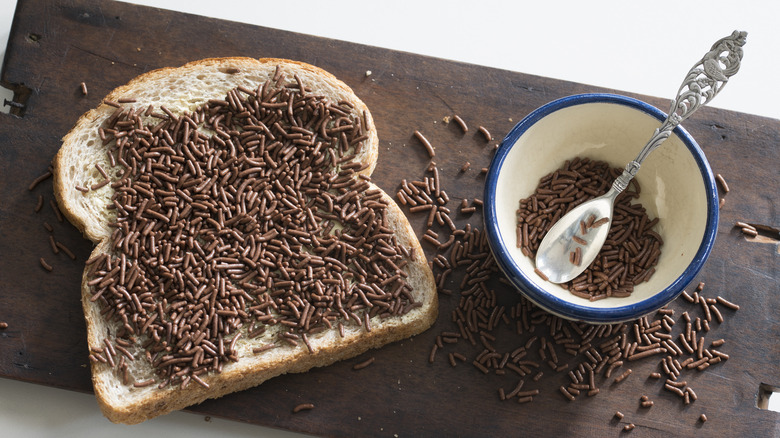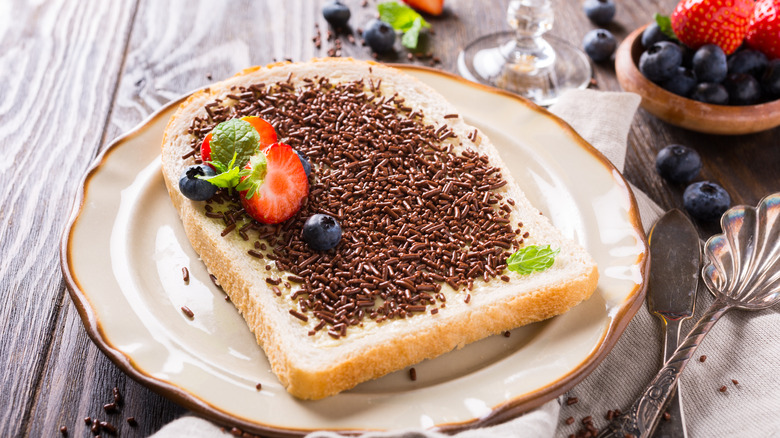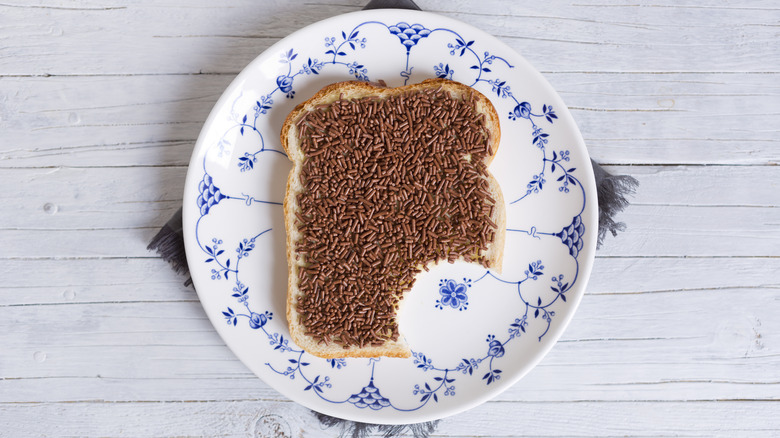Bread With Chocolate Sprinkles Is The Netherlands' Favorite Breakfast
The nuances of breakfast vary significantly across countries and cultures, yet certain elements are universally cherished. Eggs, fresh fruits, juices, cereal, and meats, often complemented by teas and coffees, stand as the pillars of breakfast. Bread and chocolate also emerge as a significant favorite, especially when combined in delectable treats such as warm pains au chocolat, stacks of pancakes with chocolate syrup, gooey chocolate muffins, or slices of toast generously covered in Nutella. For the Dutch, however, it's hagelslag that captures their hearts first thing in the morning — sweet chocolate-flavored sprinkles dusted on buttered toast, enjoyed similarly to Australian fairy bread.
The Netherlands is often considered one of the five happiest countries in the world, and perhaps chocolate sprinkles on bread for breakfast plays a part in that. According to Stuff Dutch People Like, the Dutch consume more than 30 million pounds of hagelslag each year, making it not just a breakfast staple, but the most favored bread topping overall, surpassing jams, chocolate spreads, and nut butters in popularity.
The origin of hagelslag
The name hagelslag, derived from the Dutch word for hailstorm, was inspired by an autumn hailstorm in 1919 in Amsterdam. BE Dieperink, the director of Venco — a company that produced licorice, peppermint, and gumballs among other sweets — sought a unique filling for sandwiches. The hailstorm outside sparked the idea for this confection. Originally white in color and anise-flavored, resembling tiny ice spikes, hagelslag was quite different from the chocolate version that's popular today.
Venco quickly patented the name hagelslag, leading to a burst of creativity with anise-flavored treats. In 1928, candy company De Ruijter introduced colorful fruit-flavored sprinkles known as vruchtenhagel, alongside variants flavored with orange, lemon, and raspberry. However, it was Venz, a confectionary and chocolate production company, that introduced the Netherlands to its first chocolate-flavored hagelslag in 1936 — or chocoladehagel, due to the patent. Reportedly, chocoladehagel came about from a letter sent by a five-year-old boy to Venz, asking for a chocolate bread topping!
Hagelslag isn't the same as sprinkles
Though similar in appearance to American sprinkles, hagelslag is distinct, particularly in its cocoa content. Unlike American sprinkles, which are mainly comprised of sugar, wax, and binders with minimal cocoa powder, hagelslag must contain at least 32% cocoa butter, offering a richer chocolate flavor. Additionally, Hagelslag comes in various types, including milk, dark, extra-dark, and even white chocolate.
In the Netherlands, hagelslag is often sprinkled on buttered beschuit, a round, hard rusk made from twice-baked bread. But while beschuit with hagelslag is a daily breakfast favorite, the tradition of sprinkling confections on bread extends beyond breakfast. Muisjes, meaning "little mice," is another popular sprinkle-like confection for bread, believed to be an ancestor of hagelslag. Traditionally dyed in hues of pink, blue, and white, these sugar-coated aniseeds are a customary treat at celebrations for a new baby. The practice of sprinkling sugary aniseeds on bread for special occasions dates back to the 1400s, indicating that the Dutch have been eating bread with sprinkles for centuries!



